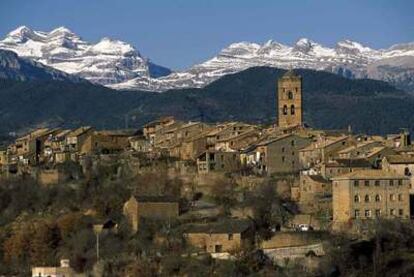Doing the Pyrenees by bus
Traveling east to west, and moving from one region to another, is no mean feat
Some time ago, the editor of a travel magazine gave me an assignment. I'd just published a story about biking across the Transpirenaica, the legendary route that cuts across the Pyrenees from the Mediterranean to the Cantabrian. "Doing the Transpirenaica on a bicycle is fine, but anyone can do that," said Sergi Ramis. "Would you dare write an article about the Transpirenaica.... by bus?"
Why not, I thought. An adventure of a non-sporting type, from bus station to bus station, to confirm the difficulties of transversal travel in a country whose radial transportation system ignores the small, isolated communities.
There were two rules: I could only use public transportation and I couldn't drift south to the larger urban hubs, from where it would have been easy to complete the adventure in under 24 hours.
And so I embarked on the most absurd and unlikely trip ever attempted by a human beinG
And so I embarked on the most absurd and unlikely trip ever attempted by a human being. It took me six days to cover 760 kilometers. It would have been faster by bike.
Day One: Llança-Puigcerdá (Girona). I fill a bottle with water from the Mediterranean to fulfill the ritual of pouring it out in the Atlantic. The commuter train takes me to Figueres. There are 14 passengers on board the 1.30pm bus to Olot, all retired folks, students under 18 and immigrants - a recurring social mix on every bus I took. The first thing the other social groups in Spain do as soon as they can is to buy themselves a car. In Olot I am told there is a 5.15pm bus to Puigcerdá. One day, three easy connections, 172 kilometers. This trip is going decidedly well.
Day Two: Puigcerdá (Girona)-Puente de Montañana (Huesca). I take the 7.30am bus to La Seu d'Urgell. At 10.15 I take a "taxi on demand," an efficient, subsidized communications system that solves the problem of isolation in the lonely mountain areas. In Sort I take a bus to Tremp, and that's where the trouble begins: changing regions in Spain is an unresolved problem for public transportation. There is no bus linking the villages of Catalonia with those of Aragon without descending to one of the provincial capitals. I have no choice but to take a taxi to Puente de Montañana.
Day Three: Puente de Montañana-Barbastro (Huesca). I take the 7.05am bus to Benabarre, and that's where it all ends. If transportation between the valleys is difficult, on weekends it is simply nonexistent. So I decide to hitchhike. An hour and a half later, two youngsters in a Peugeot 306 pull up: "We're going to Barbastro, is that OK?" "To the end of the world, as long as you get me out of here," I reply.
Day Four: Barbastro-Aínsa (Huesca). The only bus to Aínsa leaves at 8.45pm. Oh well, 12 hours should go by fast. Once in Aínsa, I take stock: in 48 hours I've done 90 kilometers. It would have been faster on foot.
Day Five: Aínsa (Huesca)-Pamplona (Navarre). I take a 2.30pm bus to Sabiñánigo and get there just in time to change to a coach going to Pamplona.
Day Six: Pamplona (Navarra)-Cabo Higer (Guipúzcoa). The coach crosses Bidasoa Valley and its thick beechwoods lead me towards the Cantabrian sea. In Irún I take a local bus to Hondarribia, where a taxi drives me to the lighthouse at Cabo Higer. There, I pour out the Mediterranean water into the docile sea. The rite is complete. I suppose there's a spot for me in The Guinness Book of World Records, for I doubt anyone ever before crossed the Pyrenees in such an absurd yet interesting manner.

Tu suscripción se está usando en otro dispositivo
¿Quieres añadir otro usuario a tu suscripción?
Si continúas leyendo en este dispositivo, no se podrá leer en el otro.
FlechaTu suscripción se está usando en otro dispositivo y solo puedes acceder a EL PAÍS desde un dispositivo a la vez.
Si quieres compartir tu cuenta, cambia tu suscripción a la modalidad Premium, así podrás añadir otro usuario. Cada uno accederá con su propia cuenta de email, lo que os permitirá personalizar vuestra experiencia en EL PAÍS.
¿Tienes una suscripción de empresa? Accede aquí para contratar más cuentas.
En el caso de no saber quién está usando tu cuenta, te recomendamos cambiar tu contraseña aquí.
Si decides continuar compartiendo tu cuenta, este mensaje se mostrará en tu dispositivo y en el de la otra persona que está usando tu cuenta de forma indefinida, afectando a tu experiencia de lectura. Puedes consultar aquí los términos y condiciones de la suscripción digital.
Últimas noticias
Maduro pleads not guilty before the federal court in New York: ‘I am still the president of Venezuela’
A new test can detect Alzheimer’s from a finger prick
UN team enters Sudanese city of El Fasher after paramilitary massacre: ‘It’s like a ghost town’
A recipe for resistance: Indigenous peoples politicize their struggles from the kitchen
Most viewed
- Gilles Lipovetsky: ‘If you want to live better and fall in love, take Prozac, don’t look to philosophy’
- Alain Aspect, Nobel laureate in physics: ‘Einstein was so smart that he would have had to recognize quantum entanglement’
- Alvin Hellerstein, a 92-year-old judge appointed by Bill Clinton, to preside over Maduro’s trial in New York
- Maduro’s downfall puts China’s relationship with Venezuela to the test
- Why oil has been at the center of Venezuela-US conflicts for decades








































